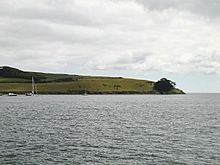Carricknath Point to Porthbean Beach facts for kids
| Site of Special Scientific Interest | |

Carricknath Point, in the west of the SSSI
|
|
| Area of Search | Cornwall |
|---|---|
| Coordinates | 50°09′49″N 4°58′29″W / 50.1637°N 4.9747°W |
| Interest | Biological |
| Area | 49.49 hectares (0.495 km2; 0.191 sq mi) |
| Notification | 2000 |
Carricknath Point to Porthbean Beach is a special coastal area in Cornwall, England. Its name comes from the Cornish words Karrik Nadh, meaning hewn rock, and Porth Bian, meaning small cove. This place is important because of its amazing plants and animals. It is officially known as a Site of Special Scientific Interest (SSSI).
Contents
What is an SSSI?
A Site of Special Scientific Interest (SSSI) is a protected area in the United Kingdom. These sites are chosen because they have special wildlife, plants, or geology. Protecting them helps keep nature healthy and safe for the future.
Exploring the Area
This SSSI covers about 49.5 hectares (that's like 122 football fields!). It is located on the south coast of Cornwall. You can find it about 2 miles (3.2 km) east of the town of St Mawes.
The SSSI is actually made up of three separate parts:
- The first part stretches from Carricknath Point to St Anthony Head. This is at the very southern tip of the area.
- The second part goes from Porthbeor Beach to Portscatho.
- The third part is at Porthbean Beach, which is further north.
The famous South West Coast Path goes right through this special area. This path lets people walk along the beautiful coastline. Some parts of the coast around St Anthony Head are looked after by the National Trust. This group helps protect important places in England. The shoreline near the water is also a special protected zone.
Amazing Wildlife
This coastal area is home to many unique plants and creatures. Each of the three sections has its own special wildlife.
Plants of the Cliffs
In the first section, near Carricknath Point, you'll find tall cliffs. These cliffs have damp, rocky ledges. A very rare plant called Shore Dock (Rumex rupestris) grows here. It is important because it is threatened around the world.
Beach and Grassland Life
The second part of the coastline has many different types of habitats. You can find sandy beaches and natural rock platforms. There are also areas with saltmarsh, which is a type of wetland. Cliff-top grasslands and low rocky headlands add to the variety.
Here, you might spot two other rare plants. One is Babington's Leek (Allium ampeloprasum). The other is Hairy Bird's-foot Trefoil (Lotus subbiflorus). Many different invertebrates, like insects and spiders, also live in this varied habitat.
Porthbean Beach's Special Plant
The third section, at Porthbean Beach, is home to Sea Kale (Crambe maritima). This plant is becoming less common across the country. Protecting this area helps it survive.

